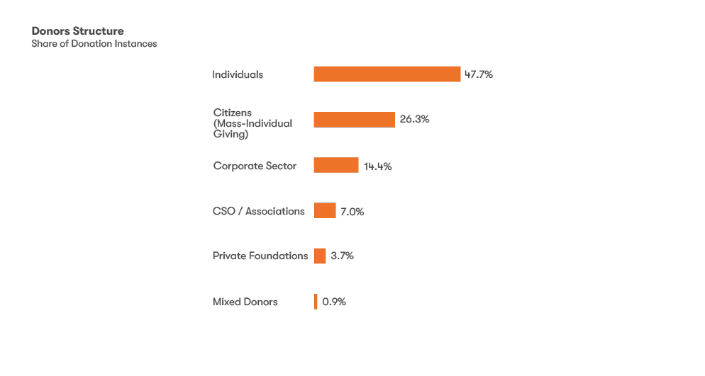In 2021, citizens and companies donated 2,220,000 EUR for the common good through 693 donation instances. The donated amount per capita was 1.2 euros.
Generous individuals remained the most active donor in 2021, with a share of almost half of all donation instances. Most of these donations were from donors from the diaspora.
Those individuals focused mostly on the topic of education in 2021, most notably by providing scholarships.
The participation of citizens (mass-individual giving) is in second place, and it has increased since 2020.

The corporate sector was less active when compared to the pandemic year; in 2021, the corporate sector had a share of 14% of all donation instances.
However, when observing the monetary value of donations, companies together with small and medium enterprises were the most generous, giving more than two-thirds of the total donated value. Some of the companies that initiated the largest number of donation instances were the Petrol Company, NLB Bank Kosovo, and the Frutex Company. One donation instance in the value of one million euros from the Frutex Company generated the majority of this share, and when this donation instance is excluded, the participation of the corporate sector in the total donated amount is significantly lower.
Some donations that stood out include the Kosovo Energy Corporation (KEDS)’s donation of fifteen computers with accompanying equipment to the „Dëshmorët e Vitise“ primary school as well as their donation of fifty computers to the SOS Children’s Villages Kosovo.
Intended Effects of Giving
One-off donations consisted of more than half of donation instances in 2021. A large portion of one-off donation instances was in the form of supplies and consumables, including humanitarian packages with food and hygiene products for socially disadvantaged families. Almost half of the donations were in the form of supplies that were donated during the holidays. When observing the monetary value of donations, one-off giving generated 28% of the amount. A significant part of this amount was donated for medical treatments, out of which a donation instance that stands out is the Labinot Tahiri Foundation’s campaign for the treatment of two people injured in an explosion in Ferizaj. This campaign raised 100,000 euros.
On the other hand, long-term support, such as equipment, capital investments, and scholarships, experienced a rise in percentage compared to the pandemic year, reaching a share of one-third of all donation instances. Still, this share is somewhat smaller than in 2019. Long-term donations were most frequently directed toward education, mainly in the form of scholarships. Equipment was also a prevalent form of long-term support in 2021. Specifically, one-third of all long-term donations were donated equipment, including assistive devices, medical equipment, and IT equipment for schools.
Download our report Giving Kosovo 2021, explore our data on philanthropy, and find out how much, to whom, and for what purposes Kosovo donated in the previous year.
This article is made possible by the generous support of the American people through the United States Agency for International Development (USAID). The contents are the responsibility of Catalyst Balkans and do not necessarily reflect the views of USAID or the United States Government.
The Citizen Engagement Activity in Kosovo is a five-year initiative implemented by Kosovar Civil Society Foundation (KCSF) in partnership with the United States Agency for International Development (USAID).


Leave a comment